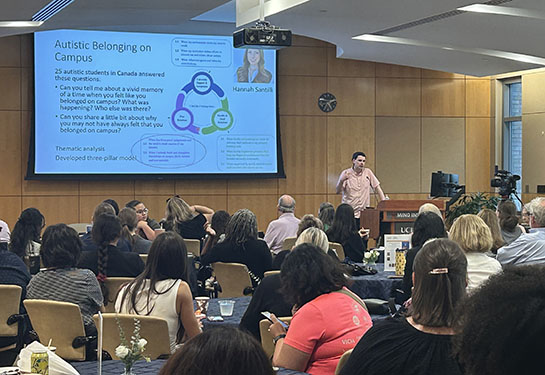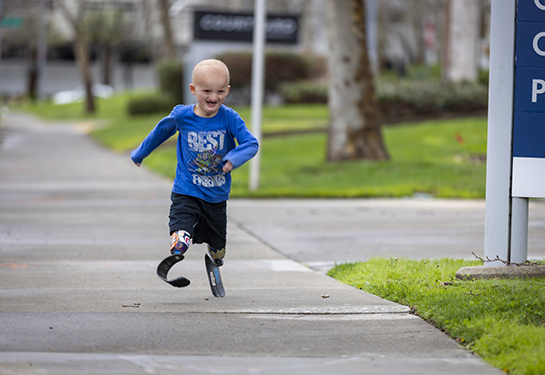Finding better ways to measure cognitive change in people with intellectual disability
Study finds NIH Toolbox Cognition Battery sensitive to developmental changes in children, teens and young adults
A major challenge in testing new therapies for people with intellectual disability is finding accurate tools to measure whether the intervention or medication works. A new study by researchers at the UC Davis MIND Institute and other institutions suggests that the NIH Toolbox Cognition Battery (NIHTB-CB) is a promising option. The study found the test to be sensitive to developmental changes in children, teens and young adults.
“People with lower developmental abilities are often excluded from research studies and clinical trials,” explained David Hessl, professor in the Department of Psychiatry and Behavioral Sciences and lead author of the paper. “That means the results of those studies do not apply to everyone, and this entire group is left out from having the potential benefit of a treatment.”
Intellectual disability is characterized by an IQ of about 70 or lower. It affects 1.8 – 3.2% of people worldwide and can occur with conditions such as fragile X syndrome, autism and Down syndrome.
Intellectual disability also presents with adaptive behavior challenges. It affects academic achievement, independence and many aspects of daily life.
What is the NIH Toolbox Cognition Battery?
The NIHTB-CB is a computer or tablet-administered test. It includes a series of brief tasks to assess cognitive functions like attention, working memory and language.
For example, there is a section that requires participants to compare two pictures and decide if they’re the same or different, and another that involves listening to a word and then pointing to the picture that goes with the word. Another section includes listening to a story and then putting images from the tale in the right order.
Measuring developmental change in young people
To assess whether the NIHTB-CB is sensitive to developmental change, the team studied young people during childhood and early adulthood – a time when kids and teens are usually developing cognitive skills and gaining abilities.
“We knew that a substantial portion of young people would be making gains in cognition during this period, and we could use that opportunity to see if the Toolbox picked up on those developmental changes,” said Hessl, who is also a MIND Institute faculty member. “Before using a measure in clinical trials, it is really important to learn whether it is sensitive to change.”
Researchers administered the NIHTB-CB to 256 individuals. Participants were in one of three groups: those with fragile X syndrome, those with Down syndrome and those with other intellectual disability. The participants ranged in age from 6-27 years. After two years, the team re-tested 197 of the participants.
To cross-validate the NIHTB-CB, the team also administered the Stanford-Binet Intelligence Scales, Fifth Edition (SB5) at both time points. The SB5 is a long-established IQ test.
People with lower developmental abilities are often excluded from research studies and clinical trials. That means the results of those studies do not apply to everyone, and this entire group is left out from having the potential benefit of a treatment.” —David Hessl, professor in the Department of Psychiatry and Behavioral Sciences
Results very promising
Overall, the developmental growth measured by the NIHTB-CB tests was similar to – or exceeded – that of the SB5. Each group’s pattern of NIHTB-CB growth also corresponded to the SB5 growth pattern.
The NIHTB-CB showed significant gains in almost all areas in participants with other intellectual disability at age 10, continued gains at 16 and stable development at age 22.
The participants with fragile X syndrome showed delayed gains in attention and inhibitory control compared to the group with other intellectual disability. The participants with Down syndrome had delayed gains in receptive vocabulary compared to the group with other intellectual disability.
Unlike the other groups, the participants with Down syndrome had significant growth in early adulthood in the areas of attention and inhibitory control and working memory.
All three groups had very little growth in cognitive flexibility - the ability to adapt to a new rule or environment.
“These findings may help to guide us in terms of where intervention would be the most effective or beneficial,” Hessl said.
A new measurement tool for clinical trials?
Many researchers dislike repeating an IQ test like the SB5 over a short period of time, as is often required for treatment studies.
“There can be practice effects for some IQ test components, as well as an emphasis on acquired knowledge-type questions,” Hessl explained. “For an outcome measure, you want something with more fluid and easily changeable components, like the NIHTB-CB.”
Some treatment studies are already using the NIHTB-CB to measure cognitive growth. That includes a small, high profile study which found that an Alzheimer’s drug increased cognitive scores in adult males with fragile X syndrome. A larger trial is now planned. Hessl is a consultant on the study of the drug company involved, Tetra Therapeutics.
Hessl notes that other possible directions for the NIHTB-CB include adapting it for use in clinics or in schools to assess patients or students.
“I think we have strong evidence that the NIH Toolbox Cognition Battery does detect changes in cognition over time. It’s not universal – not for every single subtest with all the groups that we studied – but there was enough evidence across the groups and the different tests that it’s picking up on some important elements of change,” Hessl said.
The research was published online on Dec. 2 in Neurology®, the medical journal of the American Academy of Neurology. For a complete list of coauthors, please see the publication.
The study was funded by The National Institute of Child Health and Human Development (R01HD076189), Health and Human Services Administration of Developmental Disabilities (90DD0596) and by the MIND Institute Intellectual and Developmental Disabilities Research Center (P50HD103526).
The UC Davis MIND Institute in Sacramento, Calif. was founded in 1998 as a unique interdisciplinary research center where families, community leaders, researchers, clinicians and volunteers work together toward a common goal: researching causes, treatments and potential prevention of challenges associated with neurodevelopmental disabilities. The institute has major research efforts in autism, fragile X syndrome, chromosome 22q11.2 deletion syndrome, attention-deficit/hyperactivity disorder (ADHD) and Down syndrome. More information about the institute and its Distinguished Lecturer Series, including previous presentations in this series, is available on the Web at mindinstitute.ucdavis.edu.






